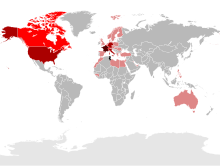
Back تونسيون Arabic تينسيين ARZ Tunesier German Pueblo tunecino Spanish Tunisiar Basque Tunisiens French Orang Tunisia ID Тунистіктер Kazakh Tunesiani Latin Tunisieši Latvian/Lettish
توانسة (Tawānisa, dialectal Tweensa) تونسيون (Tūnisiyyūn) | |
|---|---|
 | |
| Total population | |
| c. 14.2 million[a] | |
| Regions with significant populations | |
(2022 census)[1] | |
| 1,389,000[2] [3][2][4][3] | |
| 319,000 (includes ancestry)[4][5] | |
| 195,000[4] | |
| 175,685[6][7] | |
| 120,700 (includes ancestry)[8] | |
| 68,952[4] | |
| 25,650[4] | |
| 24,810[4] | |
| 20,000 | |
| 19,361[4] | |
| 18,796[4] | |
| 16,774[4] | |
| 16,667[4][9] | |
| 8,776[4] | |
| 8,704[4] | |
| 31,540[4] | |
| 10,797[4] | |
| 7,921[4] | |
| 5,693 | |
| 4,570 | |
| 3,722 | |
| 3,500 | |
| 3,413 | |
| 1,605 | |
| 1,540 | |
| 1,352 | |
| 1,340 | |
| 1,323 | |
| 981 | |
| 950 | |
| 514 | |
| 497 | |
| 349 | |
| Languages | |
| Majority: Arabic (Tunisian Arabic), French Historically: Phoenician, Punic, Canaanite, Latin, African Romance Minority: Judeo-Tunisian Arabic,[10] and Berber[11][12][13][14] | |
| Religion | |
| Predominantly Islam (Sunni Maliki)[15] Minority: Christianity, Judaism and Baháʼí Faith[citation needed] | |
| Related ethnic groups | |
| Arabs, Berber, European Tunisians, Carthaginians, Roman Africans, Italian Tunisians, Turco-Tunisians, Maghrebis and other Afroasiatic peoples | |
a The total figure is merely an estimation; sum of all the referenced populations. | |
Tunisians (Arabic: تونسيون Tūnisiyyūn, Tunisian Arabic: توانسة Twensa) are the citizens and nationals of Tunisia in North Africa, who speak Tunisian Arabic and share a common Tunisian culture and identity. In addition to the approximately 12 million residents in Tunisia, a Tunisian diaspora has been established with modern migration, particularly in Western Europe, namely France, Italy and Germany. The vast majority of Tunisians are Arabs who adhere to Sunni Islam.[16]
- ^ "National Institute of Statistics-Tunisia". National Institute of Statistics-Tunisia. 12 September 2016. Archived from the original on 10 June 2016. Retrieved 1 February 2018.
- ^ a b Répartition de la Communauté tunisienne à l'étranger en 2012 OTE (PDF). Tunis: OTE. 2012. Retrieved 7 August 2014.
- ^ a b "Résultats de la recherche | Insee".
- ^ a b c d e f g h i j k l m n o "Communauté tunisienne à l'étranger" (PDF). www.ote.nat.tn (in French).
- ^ "Communauté tunisienne à l'étranger" (PDF). www.ote.nat.tn (in French).
- ^ International Migrant Stock 2020. USA: UN. 2021. Retrieved 11 January 2021.
- ^ "International Migrant Stock 2020". United Nations.
- ^ Statistical Abstract of Israel, 2009, CBS. "Table 2.24 – Jews, by country of origin and age" (PDF). Retrieved 11 March 2019.
{{cite web}}: CS1 maint: numeric names: authors list (link) - ^ statistique, Office fédéral de la (26 August 2016). "Population résidante permanente étrangère selon la nationalité – 1980–2015 | Tableau". Office fédéral de la statistique.
- ^ Arabic, Tunisian Spoken. Ethnologue (19 February 1999). Retrieved on 5 September 2015.
- ^ "Tamazight language". Encyclopædia Britannica.
- ^ "Nawaat – Interview avec l' Association Tunisienne de Culture Amazighe". Nawaat. 27 February 2012.
- ^ Gabsi, Zouhir (2003). An outline of the Shilha (Berber) vernacular of Douiret (Southern Tunisia) (PhD). University of Western Sydney.
- ^ "Tunisian Amazigh and the Fight for Recognition – Tunisialive". Tunisialive. Archived from the original on 18 October 2011.
- ^ "Tunisia | History, Map, Flag, Population, & Facts". Encyclopedia Britannica.
- ^ "Tunisia – the World Factbook". 22 December 2022.
© MMXXIII Rich X Search. We shall prevail. All rights reserved. Rich X Search